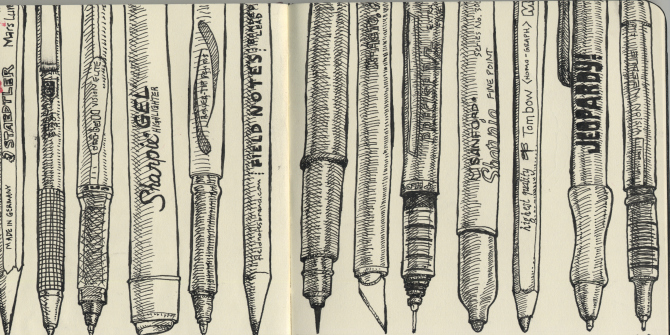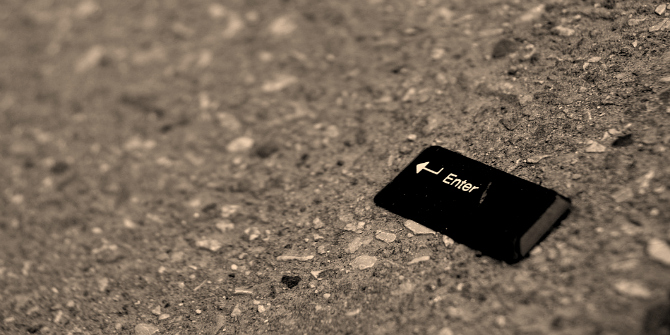With Air & Light & Time & Space: How Successful Academics Write, Helen Sword explores how academics find the ‘air and light and time and space’ to write, drawing on interviews with 100 scholars seen as exemplary writers in their fields. In underscoring that there is no one ideal way to write, this is an elegantly crafted book for those who like to experiment with and think deeply about their writing practices, recommends Fawzia Haeri Mazanderani.
Air & Light & Time & Space: How Successful Academics Write. Helen Sword. Harvard University Press. 2017.
 Find this book (affiliate link):
Find this book (affiliate link): ![]()
‘Write every day!’
‘Write first, edit later…’
‘Shut up and write!’
Anyone in academia has heard these words before. And we want to take them seriously, really we do, for writing is central to academia itself. We would like our PhDs to turn into books, the conversations we have with ourselves in the shower to transform into peer-reviewed articles, for the written word remains the primary platform from which an academic’s ideas can spring to life. Yet, too often, the blank page of possibility remains just that. Blank.
In recognition of the necessity for academics to write well and to write often, there has been a plethora of books designed to support scholars in this regard. Air & Light & Time & Space: How Successful Academics Write by Helen Sword is one such book; yet rather than providing a self-help-styled blueprint for success like many of her counterparts, the author demonstrates that there is no best way to write. The ideal state to write in is, simply, when you do. While this sentiment might seem infuriating, Sword succeeds in deconstructing the notion that ‘success’ can be achieved through specific measures and that there are overarching solutions to the struggles of writers. Instead, she asks how different academics find the ‘air and light and time and space’, in the words of Charles Bukowski, to write. She explores this through conducting over 100 in-depth interviews with academics regarded as exemplary writers in their field. This includes male and female scholars coming from a range of unconventional backgrounds, disciplines and international institutions. Through exploring the behavioural, artisanal, social and emotional habits of these writers, Sword illustrates that productivity is a broad church encompassing many creeds.
Image One Credit: Saturated image of ‘Letters’ by Marco Zanferrari licensed under CC BY SA 2.0
While reading guides or attending workshops on productive writing can engender an enthusiasm that you might have academic superhero potential if only you do this or that, Sword points out that the standard recommendation of daily writing is not easy to sustain. But here’s the real corker … she tells us THAT’S OKAY. It’s fine to write in binges, fine to write from bed, fine to write at 2am listening to Tom Petty and the Heartbreaker’s ‘I Won’t Back Down’ on repeat. Although some academics benefit from working during that spookily silent time before dawn, others might prefer to burn the midnight oil – or burn no oil at all, just write when they can. That might be while pretending to watch their child’s football match or in the dentist’s waiting room.
There are writers who benefit from ‘snack writing’: ever nibbling at the edges of multiple documents. Others prefer to feast on one body of thought and see it through to digestion. Some academics perform better in quiet offices that resemble Swedish prisons and others may benefit from wifi-less solo writing retreats in a wooden cabin somewhere (and those of us who are rubbish at chopping wood may prefer group writing retreats). Although having a room of one’s own sounds grand, it’s not always realistic – sorry Virginia, but have you checked out rental prices in London these days? – and most writers have to embrace the joys, and frustrations, of writing as a moveable feast.
In the age of technology, distractions are omnipresent, and Sword notes the need to identify where your particular weaknesses lie as well as possibly use Apps to help you along. As someone who is more about the carrots than the sticks, I am forever grateful for Sword’s introduction to a website that rewards you with a picture of a kitten once you have typed a predetermined number of words. However, her book also shows that distractions may not always be disasters. While constantly checking emails is counterproductive for most, intermittent emailing can provide a sense of instant gratification that may be a welcome form of diversification for a writing session (37).
Sword acknowledges that many of the writing tips revered as gospel may not be appealing in practice. For instance, ‘write first revise later’ is a frequently recommended strategy, encouraging writers to turn off their internal editors and scribble first drafts that read as though they were translated from Icelandic by a non-native speaker (44). Yet while free writing techniques are useful for some, those who have no problem spewing out alphabet soup may benefit more by revising and editing recursively from the start. There will always be people with meticulous writing plans and others who discover what they want to say through the writing process itself. By presenting a wide array of approaches, Sword encourages experimentation. One suggestion is that you record your writing rhythms over a period, paying attention to unconscious or habitual behaviours. This might be checking your Facebook every ten minutes or scrounging around for food each time you hit a conceptual block, even when you’re not hungry. Sword believes that undesirable habits can be rerouted in more positive directions, but this first requires recognising what they are (54).
Image Two Credit: Crop of ‘Fight with Tools’ by Nick Lee licensed under CC BY 2.0
The book also provides pointers for forming writing groups, emphasising the importance of having a clear intention behind the group’s purpose as there might be differences between gatherings that aim to provide peer feedback, those designed to generate individual productivity or sessions which serve a more reflective or motivational purpose (136). What nearly all successful writing groups have in common is a shared sense of pleasure. Pleasure is, for Sword, the key to successful writing. She is wary of the oft-repeated advice for writers to murder their ‘darlings’: a suggestion that writers should get rid of the parts of their work to which they are most attached for these are the parts that are often self-indulgent (147). Sword questions the need for such bloodshed, encouraging writers to invite positive emotions into their writing practice.
By analysing the various ways people describe their writing, she argues that metaphorical concepts exercise a powerful effect on our psyches, shaping how we think and act (180). Not only are the metaphors she provides amusing to read – ‘writing in English feels like making an Italian pizza for Italians’ (90) – they are highly identifiable. The widespread sense of fear concerning writing indicates the need for academics to accept that, at some point, their writing will return to them looking like track changes has had a nasty accident. By highlighting how others have dealt with critique and rejection, Sword shows how initial feelings of failure can potentially lead to productivity and post-rejection action.
A key theme that emerges from conversations with successful academics is that the driving force behind their writing is not only externally enforced discipline, but also self-discipline motivated by desire. While it is often true that academics chose this career path out of a love for their subject, an overemphasis on academic writing as a passion and privilege masks the darker underbelly of academia – its neoliberal working conditions. Academics should indeed appreciate the privilege of (often but not always) researching subjects that they find meaningful, but this should not come at the expense of recognising that there are very real institutional pressures that make it difficult to find the ‘air and light and time and space’ to write much more than post-it notes. There may not be literal cats crawling up our backs, as the Bukowski poem suggests, but metaphoric cats take the form of heavy teaching loads, never-ending administrative duties, critical reviewers and impending deadlines.
While Sword provides a necessary reminder of the pleasures of writing, her book inadvertently raises the need to consider how within academia love itself might be a dangerous guise, given that love alone is rarely enough to publish articles and books and submit grant proposals. There may be occasions when ‘killing joy’ can actually make room for other possibilities and ways of constructing an academic life. Real academic success needs to move beyond success only for individuals who publish. There is a need to recognise that, to paraphrase C. Wright Mills, the personal troubles of writing may partly reflect the public issues of exploitative academic environments.
I strongly recommend Air & Light & Time and Space for anyone who would like to experiment with, and think more deeply about, their writing practices. It is a book which has been crafted with great elegance (for which we should be grateful, a badly written book about writing would not be terribly encouraging!), with one section in which Sword bravely shares her own journey of writing. She does this by recording the numerous ‘false starts’ she underwent in the creation of a chapter, demonstrating that her own writing was not an effortless production but required meticulous editing (57). This act of transparency fits with Sword’s argument that successful academics should make their vulnerabilities visible: for example, by showing their ‘shitty first drafts’ to their students (195). This can help create an academic culture in which conversations about writing are demystified, and academics placed on pedestals of innate brilliance are seen as being just as susceptible as the rest of us to the whole range of emotions that a writing life evokes.
Note: This review gives the views of the author, and not the position of the LSE Review of Books blog, or of the London School of Economics. The LSE RB blog may receive a small commission if you choose to make a purchase through the above Amazon affiliate link. This is entirely independent of the coverage of the book on LSE Review of Books.










1 Comments